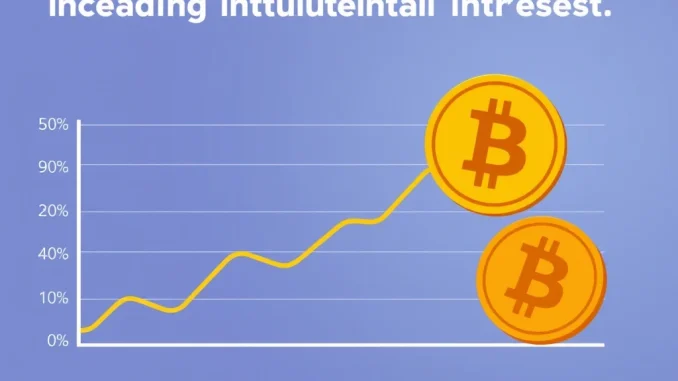
Is Bitcoin adoption hitting a plateau? Recent observations from a Fidelity executive are raising eyebrows and sparking crucial conversations within the crypto community. Jurrien Timmer, a prominent figure at Fidelity Investments, has highlighted a potentially significant trend: the number of Bitcoin wallets has remained virtually unchanged over the last year. This revelation, shared on X, prompts us to delve deeper into what this stagnation might signify for Bitcoin’s future trajectory and the broader cryptocurrency landscape. Let’s unpack this fascinating development and understand its implications.
Why Are Bitcoin Wallet Numbers Stagnant? Fidelity’s Perspective
Timmer’s analysis suggests a compelling reason behind this lack of growth in Bitcoin wallets. He posits that the current market dynamics, characterized by the entry of large institutional players, are reshaping how Bitcoin is held and managed. According to Timmer, major buyers like MicroStrategy (MSTR), known for its substantial Bitcoin treasury, and the issuers of newly launched Bitcoin ETFs, simply don’t require a multitude of wallets. Their operational scale allows them to efficiently manage their significant Bitcoin holdings with a limited number of secure Bitcoin addresses.
To illustrate this point, consider the following:
- Efficiency for Large Holders: Institutions managing vast amounts of Bitcoin prioritize security and operational efficiency. Consolidating holdings into fewer, highly secure wallets streamlines management and reduces complexity.
- ETF Effect: The rise of Bitcoin ETFs provides an alternative avenue for investors to gain exposure to Bitcoin without directly holding the asset in individual wallets. This indirect investment reduces the need for a surge in new Bitcoin wallets.
- Treasury Strategies: Companies like MicroStrategy, adopting Bitcoin as a treasury reserve asset, focus on long-term holding. Their strategy doesn’t necessitate frequent creation of new wallets, contributing to the observed stagnation.
This shift towards institutional dominance in Bitcoin accumulation could be a key factor in understanding why, despite increasing mainstream interest in cryptocurrencies, the number of individual Bitcoin wallets isn’t reflecting a parallel growth.
The S-Curve Model and Bitcoin Adoption: Is the Trajectory Changing?
Jurrien Timmer further contextualizes this observation within the framework of the S-Curve model, a concept often used to describe the adoption lifecycle of new technologies. Bitcoin, according to Timmer, has historically followed an S-Curve model. This model suggests that the value of a network-based asset like Bitcoin increases proportionally to the number of participants in that network. In simpler terms, as more people use and hold Bitcoin, its value tends to rise.
The typical S-Curve model unfolds in distinct phases:
| Phase | Characteristics | Bitcoin Context |
|---|---|---|
| Early Adoption (Innovators & Early Adopters) | Slow initial growth, driven by tech enthusiasts and visionaries. | Bitcoin’s early years, primarily used by cypherpunks and tech-savvy individuals. |
| Rapid Growth (Early Majority & Late Majority) | Exponential growth as the technology gains mainstream acceptance. | Bitcoin’s surge in popularity from 2017 onwards, attracting a wider audience. |
| Maturity (Laggards) | Slower growth as market saturation approaches, adoption plateaus. | Potentially the current phase, where institutional involvement dominates, and individual wallet growth slows. |
Timmer’s analysis suggests that we might be entering, or are already in, the maturity phase of Bitcoin’s S-Curve model. The stagnant growth in Bitcoin addresses could be an indicator that the rapid expansion phase is subsiding, and a new era of Bitcoin adoption, driven by institutional accumulation rather than individual user growth, is taking shape.
Challenges in Tracking Bitcoin’s Growth: Beyond Wallet Numbers
While the S-Curve model has been a useful framework for understanding Bitcoin’s past growth, Timmer points out a critical challenge for the future: it may become increasingly difficult to accurately track Bitcoin’s progress using this model. The reason? Traditional metrics like the number of Bitcoin addresses or wallets may no longer fully capture the nuances of Bitcoin’s evolving adoption landscape.
Here’s why relying solely on wallet numbers might be misleading going forward:
- Institutional Custody Solutions: Large institutions often utilize sophisticated custody solutions that consolidate Bitcoin holdings across multiple investors into a limited set of Bitcoin addresses. This practice obscures the true number of individuals or entities holding Bitcoin.
- Layer-2 Solutions: The increasing adoption of Layer-2 solutions like the Lightning Network, designed to improve Bitcoin’s scalability, can also impact on-chain wallet metrics. Transactions within Layer-2 networks might not always result in the creation of new on-chain Bitcoin wallets, even though user adoption is growing.
- Exchange Wallets: Many users hold Bitcoin on centralized exchanges. These exchanges control the Bitcoin addresses, and a single exchange wallet can represent the holdings of thousands or even millions of users.
Therefore, while stagnant Bitcoin wallet growth might initially appear concerning, it’s crucial to consider the evolving dynamics of the Bitcoin ecosystem. The traditional S-Curve model, heavily reliant on simple metrics like wallet counts, may need to be augmented with more sophisticated indicators to truly gauge Bitcoin’s ongoing adoption and impact.
Actionable Insights: What Does This Mean for Bitcoin Investors?
So, what are the key takeaways for Bitcoin investors from this insightful observation by the Fidelity executive?
- Shift in Adoption Metrics: Don’t solely rely on Bitcoin wallet growth as the primary indicator of Bitcoin’s health and adoption. Explore alternative metrics that capture institutional flows, Layer-2 activity, and overall network utilization.
- Institutional Influence: Recognize the growing influence of institutional investors in the Bitcoin market. Their accumulation strategies and custody practices are reshaping the landscape and impacting traditional adoption metrics.
- Long-Term Perspective: The S-Curve model, even in its mature phase, still suggests continued, albeit potentially slower, growth for Bitcoin. Focus on the long-term fundamentals and evolving use cases of Bitcoin rather than short-term fluctuations in wallet numbers.
- Diversify Your Understanding: Stay informed about the evolving metrics used to assess Bitcoin’s adoption. Look beyond simple wallet counts and consider on-chain analytics, transaction volumes, and institutional investment trends to get a more holistic picture.
Conclusion: Navigating the Evolving Bitcoin Adoption Landscape
Jurrien Timmer’s observation about stagnant Bitcoin wallet growth is a valuable reminder that the Bitcoin narrative is constantly evolving. While the traditional S-Curve model provided a useful framework in the past, the increasing dominance of institutional players and the development of new Bitcoin layers are necessitating a more nuanced approach to measuring adoption. The key takeaway is not that Bitcoin adoption is faltering, but rather that it is maturing and becoming more complex. Investors need to adapt their understanding and look beyond simple metrics to truly grasp the dynamic and enduring potential of Bitcoin in the years to come. This critical insight from Fidelity encourages a deeper, more sophisticated analysis of Bitcoin’s journey as it navigates its next phase of growth and integration into the global financial system.



